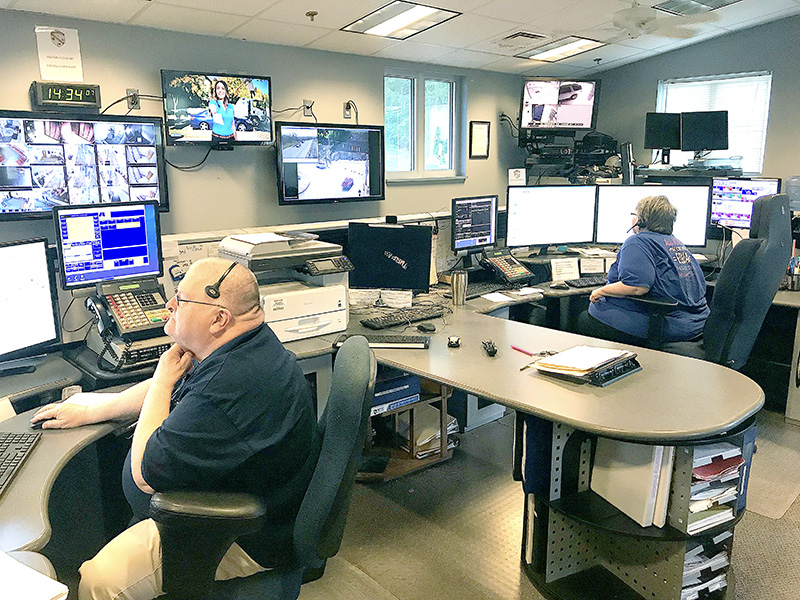
By Heather Clower
The Parsons Advocate
One of the lessons we teach our children from a very young age is who to call for help. Even kids who don’t know their own phone number more times than not know that calling 911 means help will soon be on the way. We teach them that the police and the fire fighters are here to keep us safe and the EMT’s are there to help when we are hurt. They know the result of dialing those three numbers on the phone, but do they know who is the very first, first responder?
“What is your physical location,” will be the first thing you hear from the dispatcher on the other end of the line when dialing 911. This is to ensure your location is gathered prior to getting any further into the call. They will then ask your name and a call back number in case the call is lost. The nature of the call is then determined by the dispatcher asking a lot of questions. As long as only one call is coming in at a time, one dispatcher talks to the caller while the other listens intently to determine which department to dispatch to the scene, be it law enforcement, ambulance, or fire department. They are also trained to focus on background noise to determine other information, such as the severity of a potential battery call.
“There is a lot of training these guys go through,” explained Brett Ware, Director of 911. A major requirement for anyone interested in dispatch is they must be extremely familiar with the county. Tucker County has a big tourist destination and quite often when they call in, they aren’t entirely sure of their location. “All employees have several certifications,” Ware said, including a tele-communicator I, emergency medical dispatch (both 40 hour courses), and first aid and CPR (a six to 16 hour course) to name a few. More in depth trainings are also available for continuing education courses including emergency fire dispatch and emergency law dispatch. This allows the dispatcher to provide assistance via phone until help arrives on scene, such as how to handle shock, stabilization, bleeding control, airway obstructions, shock, and more. “Part of the training is learning how to prioritize,” Ware explained. “Our goal is to not delay first responders from getting there,” but doing as much as they can from the phone until they do.
In addition to helping on the phone, the dispatchers have learned how to anticipate the needs of those being called to the scene. By gathering the appropriate information, they can inform the units how much man power may be needed, tools, or precautions to take. When an alert is sent to the responders to report to a scene, the 911 center remains in radio contact with the unit until they are back at base. This ensures the safety for everyone involved in an emergency call, not just the victims. “Any time a unit moves, it is documented in the computer system,” Ware said. They are also informed when those on the clock relocate, for example if a State Trooper who was on patrol returns to the station for work in the office.
In addition to being able to receive up to seven active 911 calls at a time before the excess is rolled to Preston County, the tele-communicators are also working with around a dozen computer systems all at once. They can monitor the road conditions at Centennial Park while also watching traffic flow at the stop light in Parsons. They also have access to the video monitors at the Court House as well as connections to local fire and burglar alarms throughout the county. For example, any time a fire alarm activates at Cortland Acres, the 911 Center is automatically alerted and the Fire Department is dispatched without a call ever being made to 911.
“The biggest challenge is false alarms, hang ups, and system call ins,” he further explained. Ware noted how important it is to stay on the line even if you accidentally call 911. It is better to stay on the line and apologize for the misdialing than to hang up, because then the dispatchers will call you back to verify if you have an emergency.
The 911 Center has made a lot of progress in recent months updating their systems and adding additional features. A new Computer Aided Dispatch System (CAD) went live in February to bring their system into the Next Generation technology era. This new unit provides vehicle locators for first responders as well as a phone app they can use when responding to calls. They are currently working towards transitioning their phone system to Internet Protocol (IP) systems so to not be relying on aging equipment. “Hopefully in the third quarter we will be able to receive texts to 911,” Ware added. “While it’s a great resource, it should not be a substitution to calling 911,” he added. While it does take less service to text verses call from a cellular device, locations can only be determined when a call is made and cannot be done so via text. Ware reiterated if at all possible, it is always better to call instead of text.
Ware, along with the two clocked in dispatchers, Pat Gray and Debbie Stemple, wanted to make sure the public knows they are always there to help. The main thing to know when calling 911 is to know where you are at, and never hesitate to call. Time can be crucial and of the essence in an emergency situation that may escalate quicker than anticipated. They all agreed, “That’s what we are here for.”


